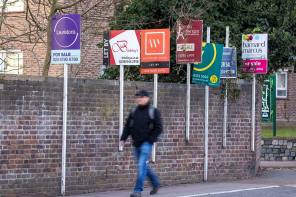

Only 13 per cent of landlords are optimistic about their future in the private rental sector and fewer than one in 10 would look to invest in more buy-to-let property, research has shown.
A quarterly report from Paragon Banking Group, out last week (July 3), found that 13 per cent of landlords felt "a little more optimistic" about their future prospects in the three months to June and none of the landlords polled felt "much more optimistic".
By comparison, a third of landlords felt optimistic in 2014 and up until this quarter, there were at least some landlords who felt "much more optimistic" about their future.
This negative sentiment is reflected in the number of landlords who said they would buy property in the next quarter.
The findings from the report, based on a poll of Paragon's 203-strong landlord panel, showed those planning to buy made up between 7 and 10 per cent of the landlord population — about three times lower than those who planned to sell (24 per cent).
Back in 2014, the market market was set to expand as between 15 and 20 per cent of landlords consistently indicated an intention to buy property, just above those planning to sell.
The figures also showed there has been a shift in the types of property landlords are opting for.
More and more landlords are choosing to invest in Houses in Multiple Occupation as they typically produce a higher yield.
This quarter’s results showed a notable year-on-year jump in those interested in purchasing HMOs from one in twenty (5 per cent) to one in five (20 per cent).
According to Paragon, this suggested a higher experience level among landlords looking to expand but also an interest in driving higher yields to offset upward pressure on costs as tax changes start to bite.
Landlords have been subject to a number of regulatory changes in recent years, with the introduction of an additional 3 per cent stamp duty surcharge on second homes in April 2016 shortly followed by cuts to mortgage interest tax relief.
Bungalows also appear to be a booming choice for landlords as more than 10 per cent would now look to purchase them as a rental property, up from about 3 per cent at the end of 2018.
Paragon’s report suggested that landlords are more careful when it comes to their finances due to the tax changes.
The average portfolio ‘gearing’ — debt funding as a proportion of total portfolio value — has dropped steadily from above 40 per cent in 2014 to 33 per cent measured today.
This reduction, combined with a trend for landlords looking to remortgage onto lower interest rate products, means landlords have been spending 5 per cent less of their rental income on mortgage payments since May 2017.
The findings suggested the market was becoming more specialist as residential landlords have about 13.1 properties in their rental portfolios — up from 12.8 on last quarter and 12.4 on last year.
According to Paragon, larger scale landlords were driving this change with those holding between 11 and 20 properties growing from 14 per cent to 18 per cent of the landlord population.
Landlords were relatively optimistic about tenant demand with almost nine out of 10 landlords (86 per cent) saying demand for rental property is either stable or booming, according to the report.
Advisers said the findings reflected what they were experiencing at the coalface as landlords and the market adjusted to the recent and ongoing changes in the sector.
Carl Shave, director at Just Mortgage Brokers, said: "While smaller investors are seemingly being deterred by the increased costs such as stamp duty and the personal tax implications as well as increased legislation, larger portfolio owners continue to see value in the sector.
"The increased trend towards more landlords considering HMOs is not surprising where landlords are looking at sources of higher yields to provide an offset against higher tax costs."
Alan Lakey, director of Highclere Financial, said the results were "no surprise" considering George Osborne had "launched a taxation attack on buy-to-let landlords" which had a "marked impact on both confidence and applications".
Mr Lakey thought the reason professional landlords making up a higher percentage of the market was down to ‘amateur landlords’ ridding themselves of property.
Kevin Dunn, director at Furnley House, agreed and added that he had found an almost complete halt on landlords increasing their portfolio.
He added: "Any new enquiries tend to be around HMO opportunities which is very in vogue and can offer better yields, however with it taking arguably more risk.
"I believe stamp duty and tax changes for higher rate tax payers have led to these changes while a typically 25 per cent deposit requirement is a barrier for some to buy."
imogen.tew@ft.com
What do you think about the issues raised by this story? Email us on fa.letters@ft.com to let us know.



